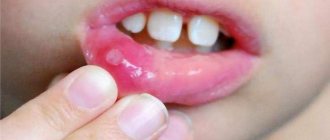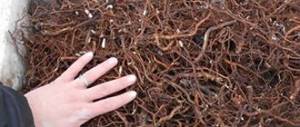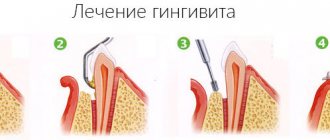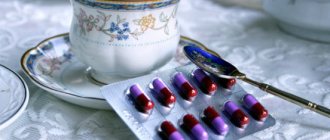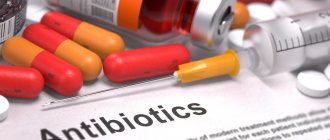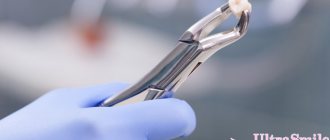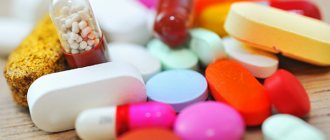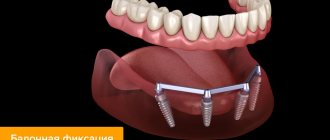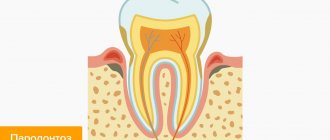Lymphadenitis is inflammation of lymph nodes of various locations and origins. Most often, it is of a bacteriological nature, but can also be caused by a number of other factors. If the lymph node is inflamed, antibiotics for lymphadenitis, along with anti-inflammatory drugs, are the main component of the therapeutic effect. The effectiveness of treatment of lymphadenitis and the likelihood of possible complications depend on their correct use.
Clinical picture of lymphadenitis
Lymphadenitis has recognizable symptoms and can be caused by a variety of factors. In some cases, swollen lymph nodes are an additional symptom of more serious diseases.
Causes of lymphadenitis
Most often, the causes of lymphadenitis include:
- hypothermia;
- a serious inflammatory process in the area adjacent to the “problem” lymph node;
- spread of infection through the lymph nodes through the bloodstream;
- presence of serious intoxication;
- oncology.
Signs of the disease
It is quite simple to identify lymphadenitis, since this pathology has characteristic symptoms. These include:
- enlargement and severe pain of the lymph nodes;
- local hyperemia of the skin and increased temperature in the diseased area of the body;
- increased body temperature and the possibility of fever;
- severe intoxication (nausea, vomiting, weakness, headache and dizziness).
What is axillary lymphadenitis
Axillary lymphadenitis is an infectious and inflammatory disease of the lymph nodes located in the axillary (axillary) region. The presented pathology is divided into:
In the first case, lymphadenitis is considered as an independent disease, since the pathological focus was initially formed in the lymph node. The secondary form occurs as a result of the introduction of microorganisms from other affected parts of the body.
Also, lymphadenitis is divided into two forms depending on the type of inflammation:
- Catarrhal, or serous, which is characterized by the following elements of inflammation: enlargement and pain. This phase is characterized by a massive release of histamine, bradykinin, prostaglandins and other alteration mediators into the lymph node.
- Purulent. This option is more severe: in addition to the effects of inflammatory factors, decay products of leukocytes and microorganisms are added. The formed fluid has a negative effect in the lymph node itself and on nearby structures, causing necrosis in them.
The catarrhal form, in itself, does not cause serious complications that threaten the life and health of the patient, but if it is not treated, it will either turn into a purulent form, or the process will become chronic.
Purulent lymphadenitis is dangerous due to complications such as:
- Sepsis - occurs due to lymphogenous and hematogenous spread of microflora throughout the body, creating new foci.
- Abscess is the release and encapsulation of pathogenic contents of the lymph node.
- Phlegmon is a massive spread of pus into the surrounding tissues with its flow into other parts of the body.
Thus, purulent lymphadenitis is a serious disease that threatens the health and life of the patient.
Causes of inflammation of the axillary lymph nodes
Inflammation of the lymph nodes in the armpits is rarely an independent disease. Most often, the cause of primary lymphadenitis is an open injury in the axillary region. In this case, the infection has open access to the lymph nodes in the axillary area.
More common causes of axillary lymphadenitis are:
- Felinosis is a cat scratch disease, an infection located under the claws enters the blood, lymph and is carried to the axillary group of lymph nodes, where inflammation occurs.
- Panaritium and paronychia are diseases characterized by infectious processes in the area of the finger and nail using the same mechanism, creating lymphadenitis.
- Hidradenitis is an inflammation of the sweat glands, which are located in close proximity to the axillary lymph nodes. The presented disease is often complicated by purulent lymphadenitis.
- Tuberculosis is characterized by enlargement and inflammation of the supra- and subclavian, mammary and axillary lymph nodes.
- AIDS is a violation of general immunity in this disease, manifested by a decrease in the barrier function of the lymph nodes, and as a result, inflammation in them.
- Mastitis affects women in 96% of cases. The close location of the mammary gland to the armpit explains the outflow of lymph there.
Nonspecific causes that cause inflammation in the axillary lymph nodes include skin diseases (atopic dermatitis, eczema, psoriasis, etc.).
Clinical picture of the disease
Inflamed lymph nodes have different symptoms depending on the cause, form and severity of the underlying disease.
- Catarrhal lymphadenitis - characterized by a slight increase (up to 38) or normal body temperature, weakness, lethargy and decreased performance are usually not observed. Locally, in the armpit, an enlarged node or group of lymph nodes is palpated or visualized. When you press on them, pain occurs or intensifies, which can radiate.
- The purulent form is manifested by the severe general condition of the patient. Body temperature is more than 38, and if complications occur, it reaches 40 degrees Celsius. Patients note weakness, lethargy, drowsiness, headaches, nausea, which may be accompanied by vomiting. In the armpit there are ball-shaped protrusions against a hyperemic background. On palpation: increased temperature in the lymph node area, fluctuation, softening and severe pain. Treatment of the presented form always includes taking antibiotics.
The feasibility of using antibiotics in the treatment of lymphadenitis
PHOTO 2. Antibiotics are the main component of complex treatment of lymphadenitis (photo: www.mosmedpreparaty.ru)
Antibiotics for inflammation of the lymph nodes are the most important link in the complex treatment of axillary lymphadenitis. The development of the disease is based on pathological microflora that enters and spreads throughout the body through the lymphatic system. With primary lymphadenitis, bacterial microflora enters the lymph nodes from the outside, and as a result they become inflamed. The etiological factor in this case is a bacterial infection (strepto-, staphylococcus, etc.).
Secondary lymphadenitis occurs as a consequence of the entry of pathogenic microflora from the primary source of infection. The feasibility of treatment with antibiotics in this case is achieved due to the effect of the drug on two negative factors at once. Indications for antibacterial therapy for secondary lymphadenitis are as follows: inflammatory complications of wounds on the arm, chest, panaritium, paronychia, hidradenitis, mastitis. Antibiotics are used in combination with other specific drugs in the treatment of tuberculosis.
Rules for taking antibacterial drugs
To begin treatment with antibiotics, you need to know certain rules for their safe use in lymphadenitis.
- It is necessary to conduct tests to find out which infection is causing the disease. Also, during the study, it becomes clear which agent is more sensitive to which pathogen.
- In order to reduce the likelihood of an allergy to a particular medicine, specialized tests are carried out before treatment and possible sources of threat are identified.
- It is necessary to strictly adhere to the dosage of the prescribed antibiotic prescribed by the doctor.
- On average, the course of antibiotic therapy is about two weeks. It is necessary to go through it completely to exclude the possibility of relapse.
- The use of antibiotics must be accompanied by the use of probiotics. The difference between their doses should be approximately two hours. And the course of use of probiotics should exceed the duration of antibiotic therapy three times.
Features of the disease and the need for antibiotics in treatment
Lymphadenitis is an investigative disease that is the body’s reaction to an infection that has entered it. The lymph node becomes aggravated in the area of the body where the infection has penetrated. For example, inflammation of the cervical node indicates the presence of a viral throat disease - influenza.
Lymphadenitis is of two types: specific and nonspecific. Specific inflammation is preceded by severe diseases such as tuberculosis, syphilis, blood cancer (leukemia), mononucleosis, etc.
Nonspecific lymphadenitis appears when pathogenic bacteria penetrate into the body, causing diseases such as colds, sore throat, toxoplasmosis, periodontitis, etc. In addition, nonspecific inflammation occurs due to infections in wounds, ulcers, and purulent formations.
At the initial stage of inflammation of the lymph node, it would be advisable to take antibiotics, which will be prescribed by the attending physician. Although there are opponents of this treatment, it is still very effective. Moreover, it is aimed not at relieving inflammation itself, but at eliminating infection from the body.
To treat lymphadenitis, a course of antibiotics is prescribed, and in addition to them, vitamin C is prescribed, which will support the immune system in the process of fighting viruses.
As a rule, a seven-day course of the antibiotic Augmentin is prescribed. If the situation remains unchanged, the course is increased to 10 days.
For treatment, a course of other, no less effective antibiotics is also prescribed:
- Amoxiclav;
- Tsiprolet;
- Azithromycin;
- Tsifran;
- Biseptol.
Choosing an antibiotic for lymphadenitis
Antibiotics for lymphadenitis are prescribed in accordance with the causative agent and the complexity of the disease. Without a doctor's prescription, only the use of topical agents, such as ichthyol ointment, is justified. In addition, heparin ointment can be used to treat lymphadenitis.
Also among the auxiliary drugs is lymphomyosot, which promotes the outflow of lymph from tissues.
As for the use of antibiotics, a fairly common method of treating lymphadenitis is the use of aminoglycosides.
Aminoglycosides
One of the first groups of antibiotics to appear. It has a wide spectrum of action, but is characterized by a large list of side effects on the human body. There are currently three generations of these drugs.
Features of application
Drugs of this class are most effective against gram-negative flora, but can be used to treat and combat other infectious agents.
Side effect
All aminoglycosides have developed nephrotoxicity; in addition, they can cause negative effects on the nervous system, respiratory function, vestibular apparatus and hearing sensitivity.
Interaction with other drugs
Aminoglycosides are among those drugs that are not used together with heparin, inhalational anesthesia, opioid analgesics and magnesium.
Also, due to the high degree of nephrotoxicity, they are not combined with drugs such as indomethacin and phenylbutazone. For the same reason, more than one aminoglycoside is not used for treatment.
Dosages
For adult patients, aminoglycosides can be prescribed two to three times a day or once (administration of the entire daily amount of the drug). The dosage of the drug during the treatment period depends on body weight, localization of the inflammatory process and filtration function of the kidneys.
What antibiotics are most often prescribed for inflammation of the lymph nodes?
Inflammation of the lymph nodes (lymphadenitis) is a fairly common disease in surgical practice. It is particularly difficult in terms of differential diagnosis, since there are a number of signs that mask it among various acute pathologies (appendicitis, peritonitis).
Therefore, it is most important to quickly correctly diagnose the disease and prescribe antibiotics for inflammation of the lymph nodes. Most often, this pathology is clinically manifested by severe pain. In addition, a huge number of pathogens, both bacterial and viral, can lead to its development.
In addition, lymphadenitis also occurs in a number of somatic pathologies (especially in oncological processes). That is why antibacterial drugs occupy one of the key places in the treatment of inflammation of the lymph nodes.
Here is a list of antibiotics for inflammation of the lymph nodes.
The role of antibiotics in the treatment of lymphadenitis
Antibacterial drugs are powerful medications that have great therapeutic potential. Their action is directed against bacterial pathogens; they are useless for viral pathologies or oncological processes. Antibiotics are usually divided into two groups based on their mechanism of action.
The first is medications with a bactericidal effect. These antibacterial agents are capable of destroying the cell wall of microbes, which leads to their lysis and death. The second group of drugs inhibits protein synthesis, which makes it impossible for further reproduction of pathogenic microflora, and also increases its sensitivity to the protective mechanisms of the immune system.
An important indicator that affects the use of antibiotics for lymphadenitis is bioavailability.
It talks about what percentage of the drug, when used, enters the blood plasma.
Clinical picture of lymphadenitis
Any bacterial pathology is manifested by various clinical symptoms. Acute or chronic inflammation of the lymph nodes is manifested primarily by local changes:
- increase in size;
- redness of the skin over the lymph nodes;
- soreness;
- an increase in local temperature over the area where lymphadenitis has developed.
Clinical symptoms often depend on the location of the affected lymph node. If it is in the abdominal cavity, then muscle tension in the anterior abdominal wall and positive peritoneal symptoms may appear. If lymphadenitis has developed in the neck, difficulty swallowing is often observed.
When the inguinal lymph nodes are affected, problems with urination and sexual function often develop. If a patient has lymphadenitis in the chest cavity, then pain in the heart area may be observed, which simulate various pathologies of this organ.
In addition, general nonspecific symptoms are observed. First of all, an increase in temperature to febrile levels (38.0˚C). Symptoms of general intoxication gradually increase - fatigue, dizziness, dyspeptic disorders (nausea, diarrhea).
In such a situation, antibiotics for inflammation of the lymph nodes are prescribed immediately.
In the future, in the absence of adequate treatment, the process turns into purulent inflammation. In this case, fluctuation of the affected lymph nodes may occur when inflammatory exudate accumulates.
Laboratory and instrumental confirmation of bacterial lymphadenitis Since lymphadenitis can be not only of bacterial origin, but also viral, it is necessary to verify the etiological factor.
For this purpose, the doctor must conduct a series of laboratory tests. First of all, he prescribes a general blood test.
During the bacterial process, there is an increase in the number of leukocytes, neutrophils and the appearance of their young forms, an increase in ESR.
Bacteriological examination makes it possible to accurately verify the pathogen. To carry it out, you need to puncture the affected lymph node. After a few days, the doctor receives information about the pathogenic pathogen, as well as its sensitivity to various antibacterial drugs.
Additionally, instrumental diagnostic methods are prescribed. They allow you to visualize the lymph nodes and distinguish lymphadenitis from other pathologies. First of all, they carry out:
- ultrasound examination (ultrasound);
- computed tomography (CT);
- magnetic resonance imaging (MRI).
Rules for taking antibacterial drugs
Antibiotics are drugs that must be consulted with your doctor before using them. Self-medication quite often leads to the development of side effects.
Also, patients often cannot choose the optimal drug for a particular pathology, so therapy in many cases does not lead to a cure.
Only a qualified doctor can accurately assess the general condition of the patient, carry out the entire necessary set of diagnostic measures and make a diagnosis of inflammation of the lymph nodes.
Antibiotics for inflammation of the lymph nodes are prescribed in a course. The duration of therapy for this pathology lasts at least 5 days. Maximum it can be 3-4 weeks. You cannot stop antibiotics on your own, as this can lead to progression of the disease and the development of septic complications.
If the patient for some reason missed taking an antibacterial drug, then he needs to take a new dose of the medication as quickly as possible, and then continue therapy as usual.
You can only take antibiotics with water.
It is prohibited to use other drinks for this purpose - soda, dairy products, strong tea or coffee, since they affect the absorption of the drug into the human body when taken orally.
Often, for lymphadenitis, a stepwise method of using the drug is used. Very often, patients with this pathology are hospitalized in surgical hospitals. Therefore, antibiotic therapy is prescribed to them in parenteral form for intravenous or intramuscular administration. Subsequently, after discharge, they are prescribed the same antibacterial drug, but in the form of tablets or capsules.
Choosing an antibiotic for lymphadenitis
The choice of antibacterial drug for a particular pathology is influenced by several factors. First of all, we need to talk about the type of bacterial flora that most often causes the disease. In the case of lymph nodes, these are streptococci and staphylococci. Therefore, antibiotics are selected that show the best effectiveness against this particular microflora.
The second component is the severity of the disease. Lymphadenitis usually gives a clear clinical picture, but its course varies from patient to patient.
In elderly people, young children, and in patients with decompensated pathologies, septic complications are much more common, which often cause death.
Therefore, in such cases, more powerful antibiotics or a combination of several drugs are chosen.
Different groups of antibiotics have different accumulation characteristics in human organs.
Advantage is given to drugs that have a good concentration in the patient’s lymphatic system.
The initial choice of antibiotic is also influenced by the history of medication use. If a patient several months ago took cephalosporins to treat pneumonia, and now has lymphadenitis, then it is necessary to give preference to another group of antibacterial agents.
An acute problem in recent years has been the increasing antibiotic resistance of microflora.
It began to arise since the active use of antibacterial drugs, but became especially acute at the beginning of the new millennium.
Drugs that were initially used for therapy and showed excellent results gradually lost their effectiveness. Other antibiotics have begun to be used instead, but their list is still quite limited.
In modern recommendations for the treatment of lymphadenitis, there is a section on first- and second-line drugs. Initial therapy includes antibiotics, which are the safest and work in the vast majority of cases. If they are ineffective or if the patient is allergic to first-line drugs, “reserve” medications are used.
Penicillins
Penicillins are historically the first antibiotics to be actively used in clinical practice. Their indisputable advantage was the wide range of bactericidal effects that this group of drugs had.
But due to their active long-term use, many bacterial pathogens have developed resistance to penicillins. However, some of their representatives continue to be actively used in clinical practice for the treatment of lymphadenitis. Penicillins are available in the form of injections and tablets. The most commonly used drugs from this group are the following:
- Amoxicillin;
- "Augmentin" (a combination of amoxicillin and clavulanic acid).
Penicillin therapy for lymphadenitis lasts at least five days. Their advantages include low toxicity and the ability to use during pregnancy and immediately after birth.
The main disadvantage is that many patients experience allergic reactions to the drugs.
Cephalosporins
The first-line drugs that are actively prescribed for bacterial lymphadenitis or suspicion of this pathology are cephalosporins. They belong to the group of beta-lactam medications, so named because of their structural molecule. They have a pronounced bactericidal effect, as well as low toxicity, which allows them to be prescribed to patients of any age.
Most cephalosporins exist only in injectable form, so they are mainly used in hospitals.
There are now five generations of this group of antibiotics. For the treatment of lymphadenitis, the third (in the first line) and fourth (in the second) are mainly used. The most commonly used drugs are:
- ceftriaxone;
- cefixime;
- cefoperazone;
- ceftazidime;
- cefepime;
- cefpir.
Among the main disadvantages of cephalosporins is the fairly frequent development of hypersensitivity reactions to them of varying severity (from ordinary redness of the skin to anaphylactic shock).
They should also not be prescribed if you are intolerant to any other beta-lactam drug (penicillins, carbapenems or monobactams).
Sometimes there is a transient increase in the amount of creatinine and urea in the blood plasma.
Antibiotic treatment of odontogenic lymphadenitis and inflammation of the lymph nodes in the neck
Odontogenic lymphadenitis is inflammation of the lymph nodes associated with inflammatory processes of the maxillofacial apparatus. Most often it affects the cervical and submandibular lymph nodes.
If the lymph node is inflamed, an antibiotic will most likely be needed during treatment. And as topical preparations, ichthyol and heparin ointments are most often used.
Treatment of this type of lymphadenitis occurs simultaneously with the elimination of the cause of inflammation. It can be a tooth severely damaged by caries or improper dental intervention. As for the use of antibiotics, fluoroquinolones and lincosamides are most often used in this case.
Fluoroquinolones
This class of drugs is significantly different from other drugs, since it affects even resistant and multidrug-resistant pathogens. In modern practice, it is customary to distinguish four generations of quinolones, the last three being fluorinated.
Drug combinations
Before using fluoroquinolones, you should carefully read certain nuances.
- It is not recommended to take quinolones simultaneously with antacids and medications containing magnesium, zinc, iron or bismuth.
- When using fluoroquinolones and nitroimidazole drugs, as well as methylxanthines, the risk of nephrotoxic effect increases.
- Combinations with nitrofuran products should be avoided.
- Due to the increased risk of tendon rupture, concomitant use of fluorinated quinolones and glucocorticoids is not recommended.
- In the process of taking drugs that alkalinize urine and fluoroquinolones, the likelihood of crystalluria significantly increases.
Dosages
The dose of application is determined depending on how severe the infection is. An important factor in determining the dosage during the treatment period is the age (child or adult) and weight of the patient. In most cases, fluoroquinolones are taken every 12 hours.
Lincosamides
A group of narrow-spectrum antibiotics aimed primarily at gram-positive cocci and anaerobic pathogens that do not form spores. Resistance to macrolides is possible. Representatives include the drugs lincomycin and clindamycin.
Dosages
The dosage for treatment with these drugs directly depends on the weight, age and condition of the patient. Drugs in this group are taken approximately every six to eight hours.
Broad-spectrum medications for pathology
The main purpose of all antibacterial drugs is to relieve the inflammatory process. The choice of one or another potent drug is determined by the degree of neglect of the pathology and the individual characteristics of the body.
Ceftazidime, which is often prescribed for inflammation of the inguinal lymph nodes, is considered an effective broad-spectrum antibacterial drug. Before using such a medication, the sensitivity of the microflora under the influence of which the pathological process developed is checked. The dosage of the drug and the duration of therapy are determined by a specialist depending on the site of infection and the severity of lymphadenitis.
Another effective antibacterial drug that can treat inflammation of the lymph nodes is Flemoxin. This medication belongs to the cephalosporin group and is usually used if the pathogen is resistant to Amoxicillin and Ampicillin.
The main contraindications to the prescription of such antibiotics is disruption of the gastrointestinal tract and kidneys. In addition, such drugs are not used if the patient is too exhausted and his condition worsens even more. Taking antibacterial drugs may be accompanied by the development of side effects such as hearing problems, dysbiosis and severe itching. In some situations, a person may experience anemia, and with prolonged use, chills are possible.
Despite the possibility of developing side effects, broad-spectrum antibacterial agents are highly effective in eliminating lymphadenitis. Taking such potent drugs should only be done under the supervision of a doctor and in compliance with the indicated dosage.
Mild inflammation of the submandibular and cervical lymph nodes
With this type of lymphadenitis, the question of what antibiotics are needed is not so pressing. First of all, local treatment is prescribed. For this purpose, you can use ointments, among which particular preference is given to ichthyol ointment. Heparin ointment is also relevant. Various lotions are also used (including those with ichthyol). Compresses with Vishnevsky ointment are very relevant in this situation.
Echinacea can be used for the symptomatic treatment of mild lymphadenitis. To do this, dilute 10 drops of the tincture of this plant in 100 ml of water. You need to drink this remedy three times a day.
As for antibiotics, in this case macrolides would be appropriate.
Macrolides
A class of drugs active against intracellular pathogens, as well as gram-positive cocci. These funds are divided into two groups according to their origin:
- natural - erythromycin, spiramycin, josamycin and midecamycin;
- semisynthetic - clarithromycin, roxithromycin, azithromycin (sumamed) and midecamycin acetate.
Dosages
The dose of drugs in this class depends on the form of the disease, as well as parameters such as the weight and age of the patient. During treatment, macrolides are most often administered every 12 hours.
When is antibiotic therapy required?
First of all, you need to see a therapist
Antibiotics for severe inflammation of the lymph nodes are prescribed by a lymphologist, immunologist, oncologist or endocrinologist. First, you always need to contact your family doctor, who will write a referral to a specialist.
For patients with lymphadenitis (inflammation of the lymph nodes), treatment depends on the pathogen and may include watchful waiting, antibiotic therapy, chemotherapy and radiotherapy. Waiting is used when the lymph nodes are smaller than 3 cm, are not characterized by redness of the skin and have been present for less than 2 weeks.
Antibiotics for severe inflammation of the lymph nodes in the neck are used when the lymph nodes are more than 2-3 cm in size, thicken only on one side, and are characterized by excessive pain and redness. Antibiotics should target common infectious causes of lymphadenopathy: Staphylococcus aureus and streptococci.
Due to the increasing prevalence of methicillin-resistant Staphylococcus aureus, antibiotic therapy with Clindamycin is recommended for enlarged lymph nodes.
Separate groups of antibiotics that are used for inflammation of the lymph nodes
In addition to all of the above groups of drugs for antimicrobial therapy, there are others. Their use may also be relevant in the fight against infectious pathogens of lymphadenitis. These drugs include penicillins, cephalosporins and macrolides. The advantage of these antibiotics is that they do not exclude the use of local agents, such as heparin or ichthyol ointment.
Penicillins
The first group of antimicrobial drugs, which is still the main component of chemotherapy treatment. All its representatives are classified into two groups:
- natural - penicillin and procaine;
- semisynthetic - oxacillin, ampicillin, amoxicillin (amoxiclav).
Cephalosporins
One of the most extensive groups of antibiotics, with a high degree of effectiveness and low toxicity. Has four generations:
- the first includes cefazolin, cephalexin and cefadroxil;
- to the second - cefuroxime (zinnate), cefuroxime-axetil and cefaclor;
- the third contains cefotaxime, ceftriaxone, ceftazidime, cefoperazone, cefixime and ceftibuten;
- the fourth generation represents cefepime.
Macrolides and lincosamides for disease
For mild inflammation of the submandibular and cervical lymph nodes, macrolide antibiotics can be prescribed. Such antibacterial drugs have a bactericidal and bacteriostatic effect and can accumulate in tissues and inside cells, which makes it possible to use them for intracellular infections.
Often, when treating lymphadenitis, an antibiotic such as Sumamed and Biseptol is prescribed. Medicines are completely absorbed when taken orally, quickly distributed throughout the body and penetrate tissue barriers. When taking such antibacterial drugs, undesirable reactions such as urticaria, heart rhythm disturbances, Lyell's and Steven-Johnson syndrome may develop.
Lincosamides have a bacteriostatic effect and are used for inflammation of the lymph nodes, which is caused by anaerobes and gram-positive flora. Antibiotics of this group can be used for odontogenic lymphadenitis due to the fact that they create a high concentration of the active substance in the inert tissue. When eliminating, pathologists may prescribe medications such as Lincomycin and Clindamycin.
